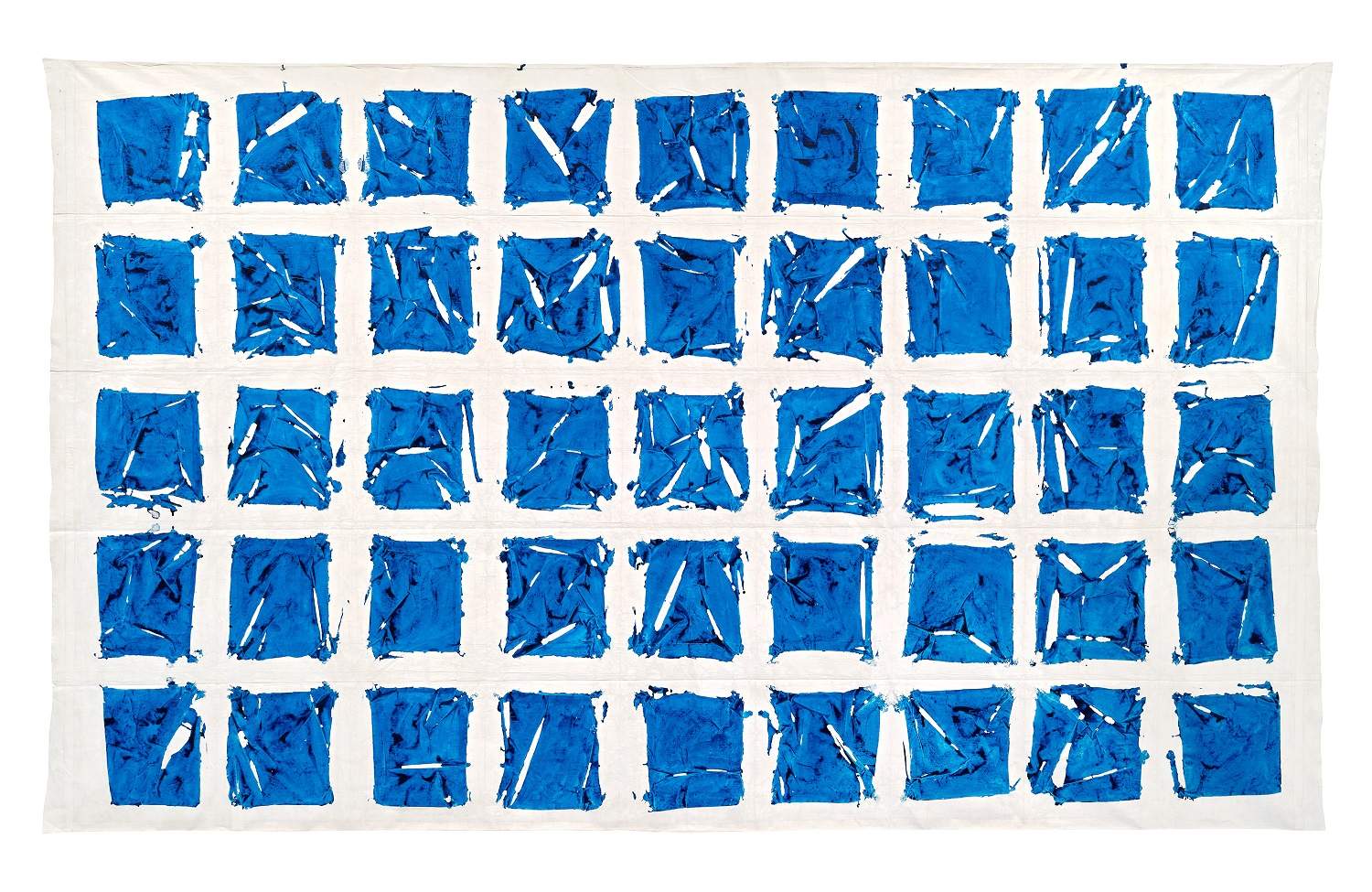The function of color: Simon Hantaï's monographic exhibition at Gagosian gallery
The Gagosian contemporary art gallery in Rome presents Azzurro, a monographic exhibition by Simon Hantaï (Biatorbágy, 1922 - Paris, 2008) on view from Feb. 2 to March 30, 2024. Curated by Anne Baldassari, the exhibition examines Hantaï’s connection to Italy and the impact of the Italian painting tradition on his work, highlighting the of blue tones in the artist’s painting practice. Following the retrospective at the Louis Vuitton Foundation in Paris in 2022, Azzurro follows Hantaï’s two previous exhibitions hosted by Gagosian: LE NOIR DU BLANC, LE BLANC DU NOIR held in the Le Bourget space (2019-22) and dedicated to black and white works; and Les blancs de la couleur, la couleur du blanc focusing on the combination of primary and secondary colors, held at the Madison Avenue venue in New York in 2022. After representing France at the 1982 Venice Biennale, Hantaï retired from public life, refusing to exhibit new work until 1998. Significantly, Azzurro takes place in Rome: in fact, Hantaï first traveled to Italy in 1942 with fellow students from the Budapest Academy of Fine Arts, staying in Rome, Florence and Siena. In 1948, he visited the 24th Venice Biennale, coming into contact with the works of Max Ernst and Jackson Pollock. These trips helped solidify his admiration for Italian painters of the proto- and early Renaissance, particularly Giotto and Masaccio.
“The function of color is essentially related to light, not matter,” said Simon Hantaï. Azure, a retrospective that is based on the use of color, presenting extraordinary examples of Hantaï’s famous pliages, a technique of folding canvas followed by knotting and painting on the visible parts, then unfolding, revealing an alternation between the background and the pigmented portions. The exhibition begins with the 1949 canvas Peinture(Petit Nu), part of the artist’s early production, where a figure emerges against a deep turquoise background reminiscent of Renaissance frescoes. This is followed by Catamurons from 1964, folded in the center and with multiple layers of color; Meun from 1967, which incorporates unpainted sections at the corners; Étude from 1969, where the uniformly folded canvas painted monochrome blue is contrasted with large, irregular fragments of white; and Blancs from 1974, where colorless segments prevail over the fragments of blue, green and black on the canvas. In the gallery’s large oval room, a group of blue paintings belonging to the Tabula series , made between 1972 and 1976, and later between 1980 and 1982, stands out. The paintings tie in with the artist’s childhood memories, fascinated by his mother’s aprons, whose tangling and folding gave rise to sequences of brilliant colors. Privileging touch over vision, Hantaï imbued the works in the Tabula series with references to historical artists, including Matisse and Cézanne, and, in blending rigor and randomness, paid homage to mathematical thought. In the last room, last studio works from 1982-85, rarely exhibited, present novel forms derived from folding and dripping, executed in vibrant and balanced colors. An additional source of inspiration for the artist is Pablo Picasso ’s Blue Period of 1901-04. Azure is accompanied by a catalog containing an essay by Anne Baldassari.
Simon Hantaï was born in 1922 in Bia, Hungary, and died in 2008 in Paris. His works appear in the collections of: Vatican Museums, Vatican City; CAPC Musée d’art contemporain de Bordeaux, France; Centre Pompidou, Paris; Musée d’Art Moderne de la Ville de Paris; Ludwig Museum, Budapest; Museum of Fine Arts, Budapest; Royal Museums of Fine Arts of Belgium, Brussels; Museum of Modern Art, New York; Solomon R. Guggenheim Museum, New York; Hirshhorn Museum and Sculpture Garden, Washington, DC; National Gallery of Art, Washington, DC; Museum of Fine Arts, Houston; San Francisco Museum of Modern Art; Musée d’art contemporain de Montréal; and Osaka City Museum of Fine Arts, Japan. Hantaï has been featured in a number of monographic exhibitions including: Hantaï, Rétrospective, Musée National d’Art Moderne, Paris (1976); Simon Hantaï 1960-1976, CAPC Musée d’art contemporain de Bordeaux (1981); 40th Venice Biennale (1982); Donation Simon Hantaï, Musée d’Art Moderne de la Ville de Paris (1997); Hantaï: Collections of the Centre Georges Pompidou, Musée d’art moderne de Céret, France (1998); Werke von 1960 bis 1995, Westfälisches Landesmuseum für Kunst und Kulturgeschichte, Münster, Germany (1999); Centre Pompidou, Paris (2013); Villa Medici, Rome (2014); Ludwig Museum, Budapest (2014); Par où on ne sait pas, Musée des Beaux-Arts, Rouen, France (2020); and Simon Hantaï. The Centenary Exhibition, Fondation Louis Vuitton, Paris (2022).
“For Hantaï,” Baldassari writes, “The same pictorial spirituality linked the Blue Period to the altarpieces and frescoes of Giotto, Masaccio, Piero della Francesca and Fra Angelico. Color was the point of contact.” Hantaï was also fascinated by the centrality of the color blue in the Catholic Marian cult, as evidenced by the painting Le Manteau de la Vierge (1960) preserved in the Vatican Museums. “By 1960,” Baldassari recounts, “having conceptualized pliage as a method, the semantic association between his mother’s apron, the color blue, and folding became a mainstay of Hantaï’s painting, the core of his artistic practice.”
Image: Simon Hantaï, Tabula (1980; acrylic on canvas, 298 × 488 cm) © Archives Simon Hantaï/ADAGP, Paris
 |
| The function of color: Simon Hantaï's monographic exhibition at Gagosian gallery |
Warning: the translation into English of the original Italian article was created using automatic tools. We undertake to review all articles, but we do not guarantee the total absence of inaccuracies in the translation due to the program. You can find the original by clicking on the ITA button. If you find any mistake,please contact us.



























